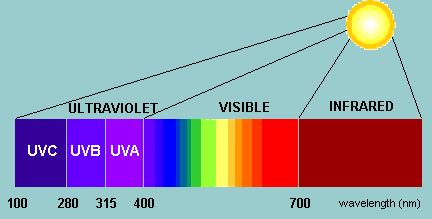- Salute e benessere
- 0 likes
- 3261 views
Everyone is wondering why your skin tans ... but few have clear ideas. The skin tans thanks to our big star, the sun, which emits solar radiation that interact with the skin itself. Thanks to ultra-violet rays, which are divided into UVA, UVB, UVC, activate the chemical processes of melanogenesis, the brown pigment producing skin coloring. The same thing happens in aesthetic solarium centers, where the radiation of light have already selected the type of lamp and filters inserted in the solar lamp. Typically these are divided into high-pressure lamps, which emit more UVA, and low pressure lamps, which abound in UVB.
Ultraviolet radiation
Solar radiation is largely absorbed by the atmosphere which acts as a real filter. The radiation that are able to cross this natural protective barrier are composed of three different types of light: - the one visible to the naked eye; - The infrared, invisible and responsible sense of warmth; - Ultraviolet light, which, with its different wavelengths is due to the much sought-after tan. The effects of these types of light on the organism are variables, as well as different is the absorption mode, 20% and 80% from the eyes from the skin. visible light (37%): it is not dangerous for the health, is very important for the regulation of the sleep-wake cycle and the trend of the hormones. This is able to stimulate the production of serotonin, an important neurotransmitter, responsible for the sense of euphoria and well-being. The infrared rays (60%): their most important characteristic is the transmission of heat to the skin surface layer (stratum corneum). Therefore, excessive consumption can damage the skin. Ultraviolet rays (3%): most of them, are reflected by the skin surface and only a small percentage are coming in the deeper layers. Depending on the wavelength, are divided into UV-A, UV-B and UV-C The most short wavelengths, are divided into UVC (200-290 nm), UVA (320-400 nm) and UVB (290-320 nm); in particular:
UV-C (100-280 nm) have very high energy but are filtered by ozone O3 and do not reach the earth's surface
UV-A (320-400 nm): they are the least energy rays (the energy is inversely proportional to the wavelength), but fail to penetrate to the dermis where they can damage collagen and elastin. UV-A radiation did not promote the maturing process of melanin, such radiation are therefore responsible for the immediate skin pigmentation (fake tan), which appears already during exposure to the sun and regresses within 2-3 hours ( " of Meyrowsky "phenomenon).
UV-B (280-320 nm): induce the most common biological reactions caused by sun exposure, they are eritematogenici and are the real culprits lasting tanning, because they stimulate melanogenesis, which continues even after exposure.
solar radiation and UV rays
What effect do UV rays on our skin?
The skin tans because it reacts, to protect, to the stimulus of UV rays. When the skin is radiated in fact they use certain biological responses:
the stratum corneum starts to thicken (hyperkeratosis) following increased mitosis of epidermal basal cells, in order to protect the skin from UV radiation;
begins to accumulate b-carotene, an antioxidant molecule that acts as a membrane stabilizer;
there is secretion, with the ecrino sweat, of urocanic acid, molecule resulting from the deamination of histidine, can absorb UVA rays;
It activates the enzymes superoxide dismutase (SOD) and glutathione (GSH);
It activates repair mechanisms and DNA replication;
It activates the main mechanism of self-protection from UV: pigmentation. At first it produces an immediate and transient pigmentation induced by UVA rays and visible light, which starts a few minutes after the first exposure and lasts 24-36 hours. Two days after the first exposure, time required to melanocytes to produce melanin, begins the delayed pigmentation in response to UVA and UVB radiation is induced by UVB radiation, the production of vitamin D in the layer of the spinous cells (anti-rachitic action ).
The skin - our bespoke suit
The fabric is woven with which the skin of our body is the most valuable, unique and tailored. The color for make it more beautiful and charming, but this is not enough to keep it healthy. In fact we have to protect from the damage that the sun can cause with suitable sunscreen products with factors of specific protections for our complexion, but especially before, during and after exposure to the sun, we need to moisturize, nourish and pamper her. Only a well-hydrated and prepared the sun tans evenly and deeply longer.






